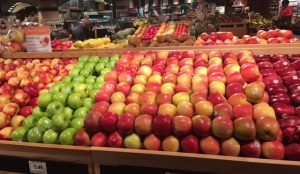
by Angela Hinkle | Oct 27, 2017

Favorite Fall Things
Photo Credit: Angela Hinkle
Fall is my favorite time of year. Let me share with you a few of my favorite Fall things to help explain why.
- Walking my dog in the heat of a summer morning is like trudging through a bowl of warm chowder. But with the cooler autumn mornings arriving, we become invigorated and feel like taking longer walks to add steps to the pedometer on my hip. Let’s hear it for more physical activity! For walking tips, check out cdc walking counts.
- Just think about all of those yummy, nutrient-dense foods available this time of year – peanuts, sweet potatoes, and squashes and gourds in a variety of shapes, colors, and sizes. See Florida Panhandle Produce in Season for seasonal produce in the Florida Panhandle.
- Okay, so leaves don’t really change color a whole lot when fall weather hits the panhandle of Florida. But I have this great tree outside my office window. My horticulture agent says it’s a Bald Cypress. This time of year, I get to see it change leaf colors from green, to golden yellow, to burnt orange. Simply beautiful. Look around your neighborhood to see what bounty of colors you can find.
- Though you will not find me wearing any shade of orange or deep yellow (those are definitely not in my color palette), I do cherish all the oranges, deep reds, purples, and yellows found in the flowers, pumpkins, scarecrows, and decorative corn stalks. Perk up your area with some fall color. Dollar stores have lots to pick and choose from.
- I’ve had my DNA tested. I am, in fact, 41% Sicilian. My holidays can therefore start with Columbus Day, work their way through the fun of Halloween, the respectful honors of Veteran’s Day, and through Thanksgiving with a myriad of Fall Harvest Celebrations sprinkled in between.
To get you in the Fall mood, try this simmering potpourri recipe. Let me know if you like it and be sure to share with family and friends some of your favorite fall things.
Favorite Fall Stovetop Potpourri
Add any or all of the following ingredients to a small pot: ground cinnamon, cinnamon sticks, orange peelings, ground ginger, whole cloves, ground cloves, vanilla extract, and almond extract. Add enough water to fill pot to rim. Then put the pot on the stove top at lowest setting. Add more water as necessary. Enjoy!
by Laurie Osgood | Oct 26, 2017

Apples are an ancient fruit, grown for thousands of years, and belong to the Rose family of plants. The Rose family also includes plums, raspberries, cherries, peaches, pears, and almonds.
According to Professor Peter C. Andersen, UF/IFAS Horticultural Sciences Department at the North Florida Research and Education Center in Quincy, the basics of apple growing haven´t changed much over the centuries. Although many homeowners in north Florida can grow apple trees, there is little potential for establishment of commercial apple orchards in Florida. Andersen says apples are difficult to grow in north Florida due to high rainfall, humidity, and insects during the apple-ripening season, which is late May through August. Apples need a chill period in order to set buds in the spring. Without a sufficient chill period, the apple tree will not cultivate. For more information on Florida apple varieties, check out Low-Chill Apple Cultivars for North Florida and North Central Florida.
Luckily, there are more than 8,000 varieties of apples grown worldwide, so you can still enjoy a selection of apples in north Florida, even if you aren’t able to grow them yourself.
Fun Apple Facts:
- Apples are very nutritious, especially when you eat the whole apple. The majority of the apple’s nutrients are in its skin.
- Apples are a good source of fiber and vitamin C and do not contain sodium, fat, or cholesterol.
- Apples ripen much faster at room temperature than if they are refrigerated.
- It takes about 36 apples to create one gallon of apple cider.
Apple Varieties:
Every type of apple has a distinct color, texture, and taste. There are more than 8,000 variations of apples grown worldwide. Here are some of the more well-known apples that are grown in the United States:
| Red Delicious |
This apple is grown in Iowa and is known for its deep red color and mild sweetness. The Red Delicious apple is finest when eaten whole or chopped up into salads. |
| Granny Smith |
This variety has a thick, green exterior with a sour taste. It is firm, crisp, and juicy inside and is best used for baking into pies and other baked goods. |
| Gala |
This variety has a waxy red and yellow skin with a golden interior. Its tart taste is ideal for baking or just eating. |
| McIntosh |
This apple grows abundantly in New England. McIntosh apples are crisp and juicy at their peak, but tend to soften quickly. This variety can be eaten off the tree or made into apple cider. |
| Golden Delicious |
This variety has a soft yellow skin and sweet flavor. This is considered an all-purpose apple that is ideal for snacking and cooking. |
| Empire: |
Empire apples are named for its home state of New York and is a mixture of a red delicious and a McIntosh apple. The Empire apple is crunchy and has a sweet taste, however, its texture changes quickly with extended storage, so it’s best eaten at its peak of freshness. |
Cooper, Emily. “Apples, a Bushel and a Peak of Flavor.” Food and Nutrition, 2017, pp. 28–29.
There are many other varieties of apples, and all are incredibly good for you. For the greatest benefits, eat the whole fruit — both skin and flesh.
To learn more about apples and their health benefits and healthy eating, please visit UF/IFAS Extension Solutions for Your Life or the USDA SNAP-Ed Connection.
by Amy Mullins, PhD, RDN | Oct 26, 2017
 We all have family traditions that make our holiday celebrations special. From your great-great-grandma’s sweet potato casserole or pecan pie, to your mother-in-law’s sausage stuffing or decadent plum pudding, there’s one thing that always seems to be a common factor among traditional holiday dishes: a massive amount of, fat, sugar, salt, and calories!
We all have family traditions that make our holiday celebrations special. From your great-great-grandma’s sweet potato casserole or pecan pie, to your mother-in-law’s sausage stuffing or decadent plum pudding, there’s one thing that always seems to be a common factor among traditional holiday dishes: a massive amount of, fat, sugar, salt, and calories!
It’s not only a single meal but rather an entire season of parties, events, gatherings festivities, and unhealthy choices that add up to that holiday weight gain we resolve to lose when January rolls around. As the holiday season begins its rapid approach, take time and consider those past eating habits that set your new year off on the wrong foot. Why not make a resolution now to eat healthier this holiday season?
Just a few simple strategies can help make the difference and keep those unwanted pounds away. Here are some suggestions:
- Don’t skip meals. Eating healthy on a regular basis will keep you from overindulging at holiday gatherings.
- Use smaller plates for meals and gatherings and be mindful of portions
- Choose more vegetables and smaller helpings of entrees and desserts
- Drink more water and minimize alcoholic drinks and eggnog
- Make healthier recipe ingredient substitutions when cooking and baking (Mayo Clinic):
- Instead of heavy cream, use fat free half and half or evaporated skim milk
- Instead of bacon, try Canadian bacon, turkey bacon or smoked turkey
- Decrease sugar in baked goods by half and add vanilla, nutmeg, or cinnamon to intensify sweetness
- Substitute applesauce or prune puree for half of the butter, shortening, or oil
- Use two egg whites or ¼ cup egg substitute for each whole egg
- Replace salt with fresh or dried herbs and spices.
We can all still experience the joy of the holiday season, without making food the focus. Make a resolution to be mindful and eat healthier this holiday season, and your waistline will thank you.
Some additional links that you may find helpful:
https://healthyforgood.heart.org/eat-smart/articles/holidays-healthy-eating-guide
https://www.cdc.gov/features/HealthyResolutions/
https://choosemyplate-prod.azureedge.net/sites/default/files/printablematerials/2013-HolidayMakeover.pdf
https://www.mayoclinic.org/healthy-lifestyle/nutrition-and-healthy-eating/in-depth/healthy-recipes/art-20047195?p=1
by Dorothy C. Lee | Oct 26, 2017
 Some 30 million Americans have been diagnosed with diabetes this year. How will their lives be affected? Diabetes does mean some big changes but you may be surprised how much diet flexibility remains.
Some 30 million Americans have been diagnosed with diabetes this year. How will their lives be affected? Diabetes does mean some big changes but you may be surprised how much diet flexibility remains.
The human body is a marvelous machine, made up of many complex systems. When everything runs smoothly, we are “healthy”. Diabetes is an example of what happens when things don’t work exactly as they should. People with diabetes cannot properly use glucose, also called blood sugar, the cells energy source. Some people make no insulin, which regulates blood glucose by helping it enter the cells. Other people produce too little insulin, or have trouble using the insulin they make, or both.
The exact cause of diabetes is unknown, but if you have a family history of diabetes, you are at great risk. The ADA estimates that almost half of all people with diabetes don’t know they have the disease. Some people ignore their symptoms until they have medical complications.
Some of the warning signs of diabetes may be symptoms of excessive thirst, unusual hunger, slow healing of infections, constant urination, blurred vision, weakness and fatigue. Recurring of these symptoms may signal the need to consult your physician.
A diagnosis of diabetes doesn’t’ have to mean dietary deprivation and boredom. The key dietary words are; low-fat, high-fiber, low-sodium, well-balanced and reduced sugar.
Exercise is another important factor in diabetes management for two reason. Active people have an easier time losing weight which is important for controlling glucose levels. Exercise also promotes the cells ability to use glucose, which in turn reduces the amount of glucose in the body to more favorable levels.
Stress reduction is an important part of a wellness program. Feeling stressed out, uptight, and edgy strains the entire body. We may not have control over the sources of stress in our life; therefore, change the way you react to life’s stressors. Physical exercise is one of the best stress reducers. Don’t take on more than you can handle. Use support systems, reach out to family and friends.
Diabetes affects many people and can have very serious consequences, but the good news is that your health habits can help prevent diabetes or reduce its impact on your health. A healthy lifestyle can help reduce the risks of disease that are often a complication of diabetes.
by Samantha Kennedy | Oct 26, 2017

Photo credit:
www.Pexels.com (Creative Commons License)
According to the National Turkey Federation, 88% of American families eat turkey on Thanksgiving. That’s over 46 million turkeys! Served as the main dish, it is complemented by a variety of sweet and savory side dishes, many of which are family traditions made from recipes passed down through the generations.
Why do we eat turkey on Thanksgiving, anyway? Well, it’s kind of a funny story. While historians generally agree that turkey wasn’t eaten at the First Thanksgiving in Plymouth in 1621, it was well-documented that settlers often hunted wild turkeys as a source of protein, and subsequent celebrations often included turkey. After President Lincoln declared Thanksgiving a national holiday in 1863, turkey became a staple on many Thanksgiving tables.
When choosing a turkey, there are a few decisions to make. How many people will be eating? Will it be roasted, smoked, or deep-fried? Is frozen or fresh preferred?
When it comes to the proper size, a pound per person is a great rule of thumb. This includes the total weight of the bird, not just the meat. Also, the ratio of white meat to dark meat is about 7:3 (70% white meat, 30% dark), so if there are a lot of dark meat lovers around the table, additional thighs and drumsticks may need to be purchased.
Roasting is the most common way to cook a turkey. This method involves placing the turkey in a large roasting pan and cooking it in the oven slowly over several hours. The turkey is usually placed breast-side up in the pan and basted periodically to prevent drying. The lid or foil is also removed the last 30 to 45 minutes of roasting time to brown the skin and give the turkey that gorgeous presentation.
Vegetables such as potatoes, carrots, or Brussels sprouts may be added to the roasting pan to cook concurrently. For best results, roast the turkey at 325˚F for 15 minutes per pound. For example, a 15 pound turkey would take 3 hours and 45 minutes.
Smoked turkeys are usually fully cooked (read the label to be sure) and just need to be reheated. Keep in mind, smoking is done to impart flavor and does not increase the turkey’s shelf life. Follow the instructions on the package to properly reheat the turkey.
Deep-fried turkeys are submerged in very hot oil and cook more quickly than roasted turkeys. Turkeys can be deep fried in a very large stockpot or in a designated turkey fryer. Only use enough oil to cover the turkey. Too much oil can cause a fire or overflow when the turkey is added to the cooker.
To determine the amount of oil, place the turkey in the cooker and add enough water to cover the bird. Then remove the bird. The water line will indicate the level of oil needed to adequately fry the turkey. For best results, let the turkey warm to room temperature before frying, and fry the turkey for 3 minutes per pound plus 5 minutes per bird.
Remember, the size of the cooker will dictate the size of the turkey. The turkey should fit easily without being forced. Wedging a turkey into a cooker that is too small could cause uneven cooking, or worse, a fire.
As for frozen versus fresh, there is no difference in flavor. However, frozen turkeys can be purchased months in advance and kept frozen until needed. Fresh turkeys should be purchased no more than two days in advance for maximum safety and freshness.
The safest way to thaw a frozen turkey is in the refrigerator. This will take pre-planning. The general rule of thumb is 24 hours of refrigerator thawing per 5 pounds. For example, a 15 pound turkey should take 3 full days (72 hours) to thaw completely.
However the turkey is cooked this year, have a Happy Thanksgiving!

by Melanie Taylor | Oct 16, 2017

Make Halloween a fun and safe night for children and adults alike.
From candy to pumpkins to the costumes, Halloween is a fun-filled time for kids and adults alike. However, it can pose dangers. To help make this year’s trick-or-treat a safe and fun time, follow these simple safety tips compiled by the American Academy of Pediatrics.
CREATIVE COSTUMES:
Plan costumes that are bright and reflective. Make sure shoes fit well and costumes are short enough to prevent tripping, entanglement, or contact with flames.
Consider adding reflective tape or striping to costumes and trick-or-treat bags for greater visibility.
Because masks can limit or block eyesight, consider non-toxic makeup and decorative hats as safer alternatives. Hats should fit properly to prevent them from sliding over eyes. The makeup should be tested on a small patch of skin ahead of time to ensure there are no unpleasant allergies on the big night.
When shopping for costumes, wigs, and accessories, look for and purchase those with a label clearly indicating they are “flame resistant.”
If a sword, cane, or stick is a part of your child’s costume, make sure it is not sharp or long. A child may be easily hurt by the accessories if he/she stumbles or trips.
Do not use decorative contact lenses without an eye examination and a prescription from an eye care professional. While the packaging on decorative lenses will often make claims such as “one size fits all,” or “no need to see an eye specialist,” obtaining decorative contact lenses without a prescription is both dangerous and illegal. This can cause pain, inflammation, and serious eye disorders and infections, which may lead to permanent vision loss.
Review with children how to call 911 if they ever have an emergency or become lost.
PUMPKIN CARVING TIME:
Small children should never carve pumpkins. Children can draw a face with markers. Then adults can do the cutting.
Consider using a flashlight or glow stick instead of a candle to light your pumpkin. If you do use a candle, a votive candle is safest.
Candlelit pumpkins should be placed on a sturdy table, away from curtains and other flammable objects, and not on a porch or any path where visitors may pass close by. They should never be left unattended.
HOME SAFETY:
To keep homes safe for visiting trick-or-treaters, parents should remove from the porch and front yard anything a child could trip over such as garden hoses, toys, bikes, and lawn decorations.
Adults should check outdoor lights and replace burned-out bulbs.
Wet leaves and debris should be swept from sidewalks and steps.
Restrain pets so they do not jump on or bite a trick-or-treater.
TRICK-OR-TREAT TIME:
A responsible adult should always accompany young children during their neighborhood trick-or-treating.
Obtain flashlights with fresh batteries for all children and adults.
If your older children are going alone, plan and review the route that is acceptable to you. Agree on a specific time when they should return home.
Only go to homes with a porch light on and never enter a home or car for a treat.
Because pedestrian injuries are the most common injuries to children on Halloween, remind Trick-or-Treaters to:
- Stay in a group and communicate where they will be going.
- Remember reflective tape for costumes and trick-or-treat bags.
- Carry a cellphone for quick communication.
- Remain on well-lit streets and always use the sidewalk.
- If no sidewalk is available, walk at the far edge of the roadway facing traffic.
- Never cut across yards or use alleys.
- Only cross the street as a group in established crosswalks (as recognized by local custom). Never cross between parked cars or out of driveways.
- Do not assume the right of way. Motorists may have a hard time seeing Trick-or-Treaters.
- Just because one car stops does not mean others will!
- Law enforcement authorities should be notified immediately of any suspicious or unlawful activity.
HEALTHY HALLOWEEN TIPS:
A good, healthy dinner prior to parties and trick-or-treating will discourage children from filling up on Halloween treats.
Consider purchasing non-food treats for those who visit your home, such as coloring books, stickers, or pens and pencils.
Wait until children are home to sort and check treats. Though tampering is rare, a responsible adult should closely examine all treats and throw away any spoiled, unwrapped or suspicious items.
Try to ration treats for the days and weeks following Halloween to prevent overindulging, which will lead to a stomachache and ruin the night’s fun.
Make sure the Halloween night is fun and safe with the suggested tips above. These tips will help guarantee you all a ghoulishly good time.
Source: American Academy of Pediatrics








